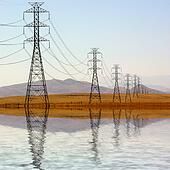Daphine briefs the MD & CEO about their training in KPLC on behalf of the other Trainee Graduates
Thomas makes a point
Eng. Joel Kiilu wishing the Engineers a fruitful time in the hands of Power Grid Corporation in India. He urged them to view themselves as KETRACO's and Kenya's Ambassadors while they are in India.
After six months of on- the job training, all 20 graduate trainees were bid goodbye by the MD and CEO during a lunchon ceremony attended by amongst others Head of Technical, Dr. John Mativo, Mr. Fernandes Barasa, Head of HR & Administration, Agnes Ongadi amongst other managers. The budding engineers were congratulated on successfully completing the first phase of their training at KPLC. They are now proceeding to India for ten weeks before completing their training in Kenya. The Trainees who are drawn from the electrical, civil and telecommunications disciplines also include six ladies.
The trainees will spend the 10 weeks furthering their exposure at Power Grid Corporation of India facilities. While in India, they will be exposed to the cutting-edge technologies and practices in transmission Line (T/L) design and costing, substation design and costing, network analyses and power system planning, and operational constraints of interconnection projects.
Learn more about PowerGrid HERE




